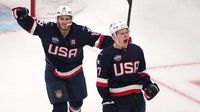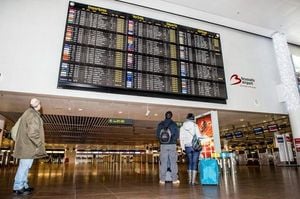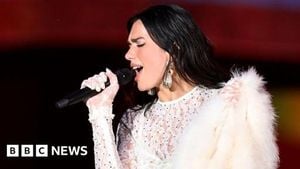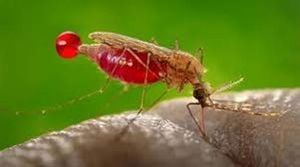The countdown to the 2026 Winter Olympics in Milan is officially on, and the world of hockey is buzzing with anticipation. Following the resounding success of the 4 Nations Face-Off last February, which delivered edge-of-your-seat action and a taste of what’s to come, Team USA is gearing up for what promises to be a historic men’s hockey tournament. For the first time in 12 years, NHL players will lace up their skates on Olympic ice, and expectations have never been higher.
But that’s not the only seismic shift shaking up the hockey landscape. The NHL and NHLPA have agreed to implement a playoff salary cap beginning with the 2025-26 season, just in time for the 2026 Stanley Cup playoffs. This move, confirmed by insider Frank Seravalli and echoed by league commissioner Gary Bettman, is set to change the way teams build their postseason rosters and could have far-reaching effects on both the NHL and international competition.
As Team USA gathered for their orientation camp in Plymouth, Michigan, last week, the air was thick with determination and a dash of nerves. “The expectation is to go to Milan and win the gold medal,” Vegas star Jack Eichel declared at the camp. “I think anything short of that, it would be disappointing.” With a deep talent pool and the memory of the 1980 Miracle on Ice still lingering in the background, the stakes are sky-high.
General manager Bill Guerin and his staff face some difficult decisions ahead. The 44-player camp roster featured not just the 23 who played at 4 Nations, but also injury replacements and young up-and-comers like Jackson LaCombe, Frank Nazar, Shane Pinto, and Alex Vlasic. These youngsters earned their invitations by helping the U.S. men’s team win the world championships for the first time in 92 years—a feat that didn’t go unnoticed. “We’re doing things differently now, and the world championships are absolutely connected to this,” Guerin explained. “If you’re saying no and you don’t have a legit excuse, it will hurt you.”
For some, the road to Milan has been paved with adversity. Matthew Tkachuk, a key figure for both Team USA and the Florida Panthers, missed the orientation camp as he recovered from offseason surgery on his adductor muscle and a sports hernia, injuries that also kept him out of Florida’s last 25 regular-season games. “I think it’s a full expectation of him not just to play but be at his best,” his brother Brady Tkachuk said, exuding confidence in Matthew’s recovery and preparation. Coach Guerin echoed that optimism, saying he was “planning and expecting” for Tkachuk to be ready for the Olympics.
Motivation is running high, especially for those who have felt the sting of being left off a roster. Tage Thompson, who scored 33 goals and 54 points over his final 57 games of the 2024-25 NHL season, admitted, “When I received the news, obviously it sucked. That was a big goal of mine and I wanted to be on the team.” Thompson, now 27, believes his size, speed, and versatility make him a valuable asset for Team USA, whether it’s on the penalty kill, power play, or any other role. “You’re looking at the 25 best players in the country,” he said. “So now it’s, what role are you going to play and who is going to do their job the best? I believe I can do any of those roles the best.”
The U.S. management team is leaving no stone unturned. John Tortorella, a veteran coach and former member of the Team USA staff, has been tasked with scouting bubble players during the 2025-26 NHL season. Tortorella, described by head coach Mike Sullivan as the “old wise man,” will be on the road early, keeping a close eye on those fighting for a spot on the Olympic roster.
Competition is fierce, especially on the blue line. With stalwarts like Quinn Hughes, Charlie McAvoy, Jaccob Slavin, and Zach Werenski all but locked in, the final defensive spots are up for grabs. Seth Jones, whose trade from Chicago to Florida revitalized his career, is firmly back on the radar after logging heavy minutes during the Panthers’ 23-game Stanley Cup run. “I’m comfortable with where I’m at; over a long playoff run you can show you can play with that physicality, and in different situations over those 2½ months,” Jones said. “Hopefully they saw that.”
Injuries have played a significant role in roster construction. Quinn Hughes, for example, missed the 4 Nations tournament due to an oblique injury, which led to further complications. “I tore my oblique, then came back a little too early and hurt my groin because my oblique was probably weak,” Hughes revealed. Despite a challenging season, he used the summer as a “mental and physical reset” and is eager to make his Olympic debut.
The camaraderie among the players is palpable. The Tkachuk brothers—Brady and Matthew—shared a special bond during the 4 Nations, while the Hughes brothers (Quinn, Jack, and Luke) are hoping to suit up together for the first time on the Olympic stage. “It’s something we’ve always dreamed of, to play with each other and wear the crest,” Luke Hughes said. “The three of us to do that together would be such an honor.”
Meanwhile, the NHL’s new playoff salary cap rules are looming large over the upcoming season. Starting with the 2025-26 campaign, teams must remain cap-compliant for every playoff game, with no exceptions for long-term injured reserve—a loophole previously exploited by Cup-winning teams like Chicago, Tampa Bay, Vegas, and Florida. The cap will rise to $95.5 million, but general managers will have less flexibility at the trade deadline, as full salaries will count for playoff eligibility, and double salary retention in trades is now banned. Deferred pay in contracts is also out, and new dress code and endorsement rules (including wine and spirits) take effect immediately.
NHL commissioner Gary Bettman hailed the new collective bargaining agreement as a source of “stability and clarity” for teams, players, and business partners. “It gives everybody a sense of stability, a sense of certainty ... optimism that everything is going well and will continue to fuel the growth that we’ve seen. It’s all good,” Bettman said, as quoted by NHL.com. The current CBA runs through September 15, 2026, with the extension kicking in the very next day and lasting through 2030.
With the Olympics and the NHL postseason both set for a major shakeup, the next hockey season promises to be one of the most competitive and unpredictable in recent memory. Players are fighting not just for their teams, but for a chance to represent their country on the world’s biggest stage. As Seth Jones put it, “It’s going to be interesting playing for your team, your personal team, then in the back of your mind, you’re kind of playing for this as well, right?”
As the puck drops on the new season, all eyes will be on the players battling for those coveted Olympic spots—and on the general managers navigating the brave new world of the playoff salary cap. One thing’s for sure: the road to Milan and Stanley Cup glory just got a lot more interesting.





